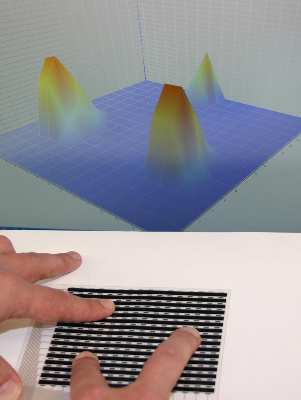Following on from Peratech's announcement about its work on QTC™ inks for printing pressure sensitive sensors and switches, the company has announced that a paper on the subject is available on the Institute of Physics website. The paper is free to download during April 2013 at http://iopscience.iop.org/0957-4484/24/16/165501/
 Multi-touch screen printed QTC touch sensor
Multi-touch screen printed QTC touch sensor
"We currently have four PhDs and other scientists and technicians researching into the exciting field of Quantum Tunnelling Composites at Durham, Leeds and London universities," explained David Lussey, Peratech's CTO and founder. "About 90% of our R&D is actually being done externally to Peratech and takes advantage of the outstanding facilities available to British companies if they link up with British Universities. This latest paper covers the mechanism of how QTC materials operate. It is research like this that will enable QTC sensors and switches to become a mainstream technology as it enables the cost, size and weight of switches to be cut by as much as 90% to enable them to become the HMI technology that everyone touches."
The paper covers a screen-printed functional ink, comprising a combination of semiconducting acicular particles, electrically insulating nanoparticles and a base polymer ink, is described that exhibits pronounced pressure sensitive electrical properties for applications in sensing and touch sensitive surfaces. The combination of these components in the as-printed ink yield a complex structure and a large and reproducible touch pressure sensitive resistance range. In contrast to the case for some composite systems, the resistance changes occur down to applied forces of less than 0.01N. Current voltage measurements at fixed pressures show monotonic non-linear behaviour, which becomes more Ohmic at higher pressures and in all cases shows some hysteresis. The physical basis for conduction, particularly in the low pressure regime, can be described in terms of field assisted quantum mechanical tunnelling.